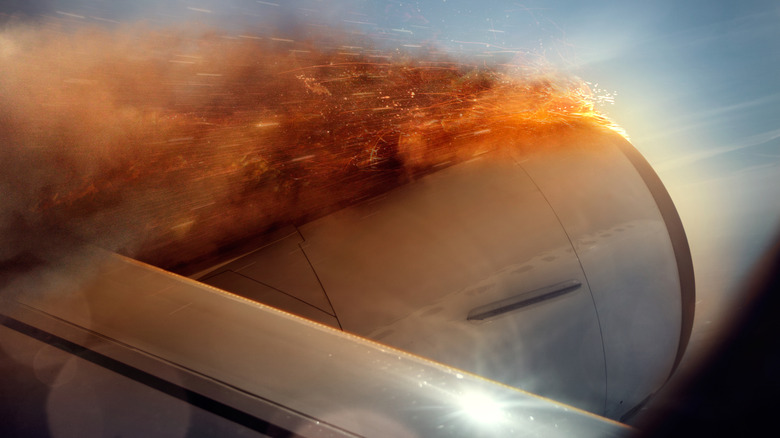Something nobody ever wants to see when they look out the window of a plane is black smoke or flickering flames billowing from one of the plane’s turbine engines. Action movies may have you believe that the engine is about to explode and take the whole vehicle down with it, but that’s probably not going to happen. Airliners can still fly if they lose one engine, so the plane will coast on its other engine(s) to a nearby airport for a safe landing, and the worst that’ll happen to you is a lengthy delay and waiting in a terminal.
Advertisement
Engine fires are an occasional occurrence on any plane equipped with a jet engine, and they can certainly be alarming for both passengers and crew when they occur. It’s for this exact reason, though, that there is both technology and procedure in place to halt the flame and manage its impact until the plane can be safely landed and the problem can be addressed directly by a repair crew.
Fires can be caused by fuel leaks and sudden impacts
Plane engines are always “on fire” to a certain extent. That’s how a jet turbine works, after all — fuel is constantly being burned in the combustion chamber and expelled outward to create thrust. You can sometimes catch a little burp of fire out the back of the engine, usually due to excess unburned fuel or a minor mechanical hiccup, but this isn’t the same thing as a full-on engine fire.
Advertisement
A full-on engine fire is most frequently caused by one of two problems: a leak in a fluid line or a sudden external impact. In the former case, if there’s some kind of physical problem in the plane’s structural integrity, especially around the lines that deliver fuel or hydraulic fluid, those fluids can leak out in the vicinity of the engine. It’s already very hot in that vicinity, so sudden, unwanted combustion is possible.
As for sudden impacts, any kind of solid object colliding with the front of the engine can cause a spark in the moving components and ignite a full-on fire. Obviously, there isn’t much in the way of inanimate objects floating in the air, but a sudden impact from a wayward bird or an illegally piloted drone that hits a plane can cause this kind of problem.
Advertisement
Engine fires are uncommon, and procedures are in place to address them
Modern planes are built both to resist sudden fires and to deal with them when they occur. If a fire is detected in one of the plane’s engines, there’s a fairly straightforward order of operations.
First, the flow of fuel to the affected engine is cut off. No fuel to burn means nothing to keep the fire growing. Secondly, the engine’s built-in fire extinguishers are activated. Modern plane engines have firefighting systems built right in. Depending on the severity of the fire and the plane’s systems, the crew may temporarily halt engine activity until the flames can be extinguished. Once everything is under control, the pilots will guide the plane to the nearest safe haven on whatever engine power is left.
Advertisement
But engine fires are fairly uncommon. Service crews always inspect planes before takeoff, so any potential fire hazards are usually caught before they can cause a problem. And bird strikes are extremely rare, with only around 3 in 10,000 planes experiencing them, Yahoo News reported. Only 2% to 8% of those very few bird strikes actually damage planes’ engines, including starting an engine fire.
Illegally piloted drones near-missing planes on takeoff is a problem, and there is a definite possibility of engine damage should an impact occur. That said, there have only been a handful of drone impacts to date, so the odds are still very low.







